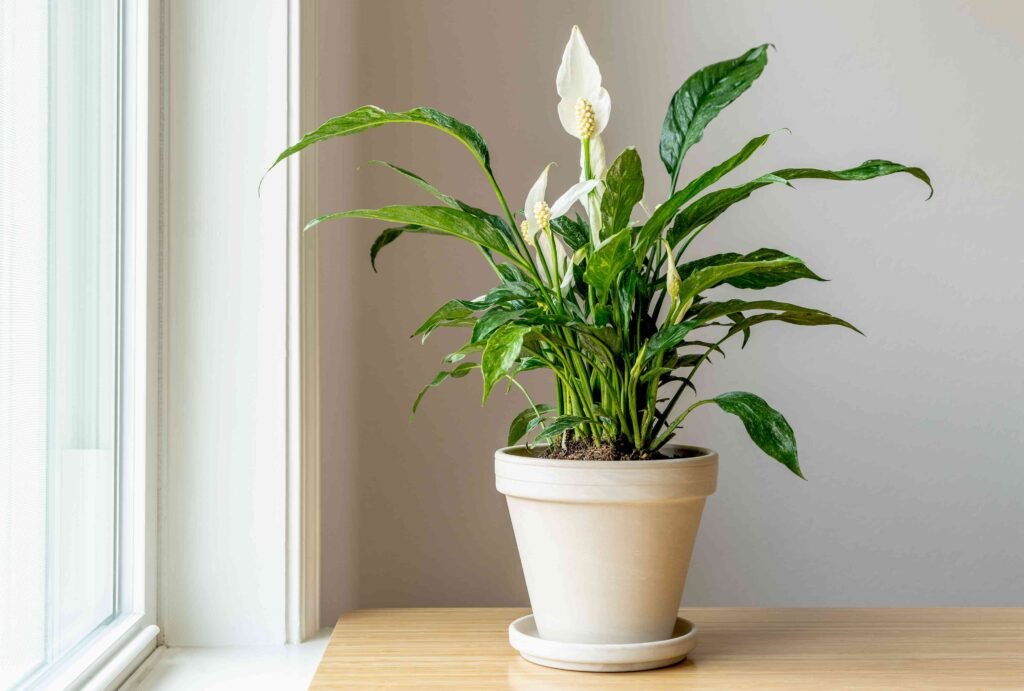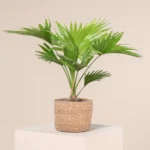Categories
Houseplants, Flowering Plants, Air-Purifying Plants, Low-Light Plants, Tropical Plants
Introduction
The Peace Lily (Spathiphyllum) is a beloved houseplant known for its elegant white flowers and glossy, dark green leaves. Native to tropical regions of the Americas and southeastern Asia, this plant has become a popular choice for both homes and offices due to its air-purifying qualities and ability to thrive in low-light conditions.
The genus name Spathiphyllum is derived from the Greek words “spath” (spoon) and “phyl” (leaves), referring to the shape of the flower spathe. Peace Lilies are not true lilies but belong to the Araceae family, which includes other popular houseplants like Philodendrons and Pothos.
Peace Lilies gained widespread recognition after NASA’s Clean Air Study in the late 1980s, which identified them as one of the top plants for removing indoor air pollutants. This scientific endorsement, coupled with their low-maintenance nature and attractive appearance, has solidified their place as a staple in indoor plant collections worldwide.
Real-world event: In 2022, a study published in the journal “Environmental Science and Pollution Research” highlighted the Peace Lily’s ability to absorb and metabolize benzene, a common indoor air pollutant. This research further boosted the plant’s popularity, especially in urban areas with concerns about indoor air quality.

Care Guide
- Light:
Peace Lilies thrive in low to medium indirect light. They can tolerate lower light conditions but may not flower as prolifically. Avoid direct sunlight, which can scorch the leaves. - Water:
Keep the soil consistently moist but not waterlogged. Peace Lilies are dramatic and will droop when thirsty, but quickly perk up after watering. It’s best to water when the top inch of soil feels dry. - Humidity:
These tropical plants prefer higher humidity levels. Mist the leaves regularly or place on a pebble tray filled with water to increase humidity around the plant. - Temperature:
Peace Lilies do best in temperatures between 65-80°F (18-27°C). They’re sensitive to cold drafts and temperatures below 55°F (13°C). - Fertilizer:
Feed monthly during the growing season (spring and summer) with a balanced, water-soluble fertilizer diluted to half strength. Reduce or stop fertilizing in fall and winter. - Pruning:
Remove yellowed or brown leaves at the base. Cut spent flowers at the base to encourage new blooms.
Soil and Potting/Repotting
Soil:
Peace Lilies prefer a rich, well-draining potting mix. A good mixture includes:
- 2 parts peat moss or coco coir
- 1 part perlite
- 1 part composted bark
This mix provides good moisture retention while ensuring adequate drainage.
Potting:
Choose a pot with drainage holes that’s about 1-2 inches larger in diameter than the current pot.
Repotting:
Repot every 1-2 years or when the plant outgrows its current pot. Spring is the best time for repotting. Steps include:
- Gently remove the plant from its current pot.
- Loosen the root ball and remove any dead or rotting roots.
- Place in the new pot with fresh potting mix.
- Water thoroughly and place in a shaded area for a few days to recover.

Health and Diseases
Common Pests:
- Mealybugs
- Spider mites
- Scale insects
Treatment:
- Isolate affected plants.
- Wipe leaves with a solution of water and mild soap.
- For severe infestations, use neem oil or insecticidal soap.
Diseases:
- Root rot: Caused by overwatering or poor drainage.
- Leaf spot: Fungal disease causing brown spots on leaves.
Prevention and Treatment:
- Ensure proper watering and good air circulation.
- Remove affected leaves promptly.
- For fungal issues, treat with a copper-based fungicide.

Business: How to Make Money and Beyond
- Plant Sales:
- Grow and sell various Peace Lily varieties.
- Offer different sizes for various spaces and budgets.
- Air Purification Services:
- Provide plant-based air purification solutions for homes and offices.
- Create “Clean Air Plant Packages” featuring Peace Lilies.
- Plant Care Services:
- Offer maintenance services for office plants, including Peace Lilies.
- Provide “plant sitting” services for vacationing plant owners.
- Educational Content:
- Create online courses about indoor air quality and plant care.
- Write e-books on low-light plants and their benefits.
- Specialty Products:
- Develop custom fertilizers for Peace Lilies and other indoor plants.
- Design stylish, self-watering pots ideal for Peace Lilies.
- Plant Rentals:
- Offer Peace Lily rentals for events or temporary office decor.
- Consulting:
- Provide consultations on using plants for improving indoor environments.

Variety and Price Table
| Variety | Average Price (USD) |
|---|---|
| Spathiphyllum ‘Mauna Loa’ | $20 – $40 |
| Spathiphyllum ‘Domino’ | $25 – $50 |
| Spathiphyllum ‘Sensation’ | $40 – $80 |
| Spathiphyllum ‘Petit’ | $15 – $30 |
| Spathiphyllum ‘Starlight’ | $30 – $60 |
Regional Price Comparison Table
| Country/Region | Average Price (Local Currency) |
|---|---|
| USA | $25 – $60 USD |
| UK | £20 – £50 GBP |
| Australia | $30 – $75 AUD |
| Canada | $30 – $70 CAD |
| Germany | €22 – €55 EUR |
FAQs
- Q: How often should I water my Peace Lily?
A: Water when the top inch of soil feels dry, typically once a week. - Q: Are Peace Lilies toxic to pets?
A: Yes, they’re toxic to cats and dogs if ingested, causing irritation and digestive issues. - Q: Why isn’t my Peace Lily flowering?
A: Lack of flowering can be due to insufficient light or lack of nutrients. - Q: How do I propagate my Peace Lily?
A: Divide the plant during repotting, ensuring each division has roots and leaves. - Q: Why are my Peace Lily’s leaves turning yellow?
A: This can be due to overwatering, underwatering, or too much direct sunlight. - Q: Do Peace Lilies need to be misted?
A: Misting can help increase humidity, which Peace Lilies enjoy, but it’s not strictly necessary. - Q: Can Peace Lilies grow in water?
A: While they can survive in water, they thrive best in soil for long-term health. - Q: How big do Peace Lilies get?
A: Most varieties grow 1-3 feet tall, but some can reach up to 6 feet. - Q: Why are the tips of my Peace Lily’s leaves turning brown?
A: This is often due to low humidity, overfeeding, or sensitivity to fluoride in tap water. - Q: How long do Peace Lilies live?
A: With proper care, Peace Lilies can live for many years, often 3-5 years or more.
Quick Facts Table
| Attribute | Detail |
|---|---|
| Scientific Name | Spathiphyllum spp. |
| Common Names | Peace Lily, White Sail Plant |
| Native Region | Tropical Americas and Southeast Asia |
| Plant Type | Tropical perennial |
| Mature Size | 1-6 feet tall, depending on variety |
| Growth Rate | Moderate |
| Flower Color | White |
| Flowering Period | Spring to fall |
| Light Requirement | Low to medium indirect light |
| Water Requirement | Moderate, keep soil consistently moist |
| Humidity | Prefers high humidity |
| Temperature Range | 65-80°F (18-27°C) |
| Soil Type | Well-draining, rich potting mix |
| Toxicity | Toxic to pets and humans if ingested |
| Propagation Methods | Division |
| Air Purification | Excellent, removes multiple pollutants |

Peace Lily, Spathiphyllum, air-purifying plants, low-light plants, indoor plants, tropical houseplants, flowering indoor plants, NASA clean air study, plant care, humidity-loving plants, office plants, air quality improvement, plant propagation, pet-friendly plants alternatives, indoor gardening
Views: 6











